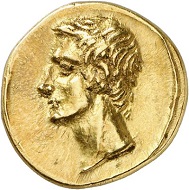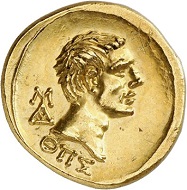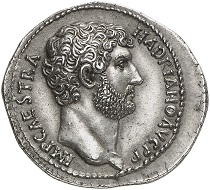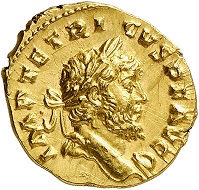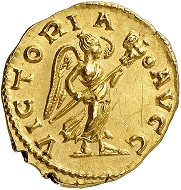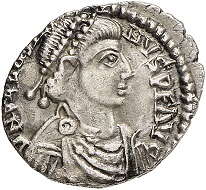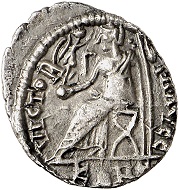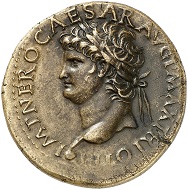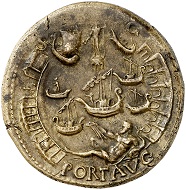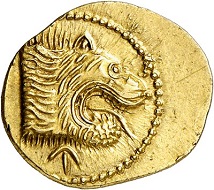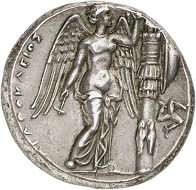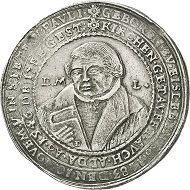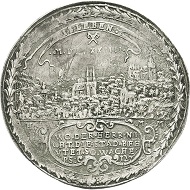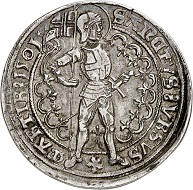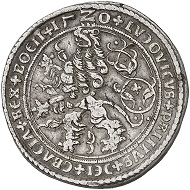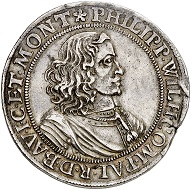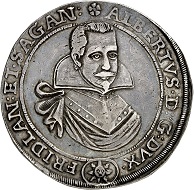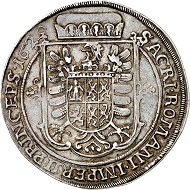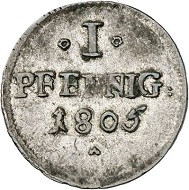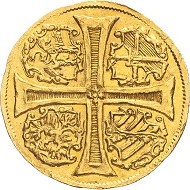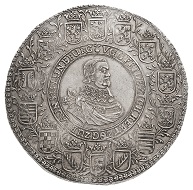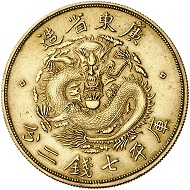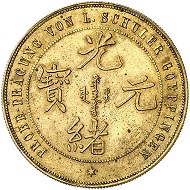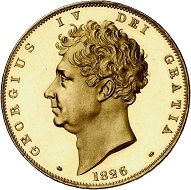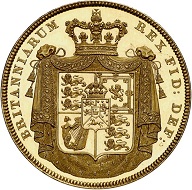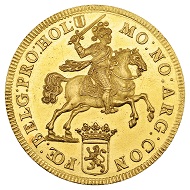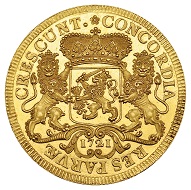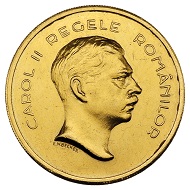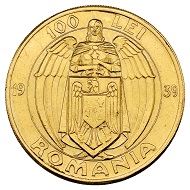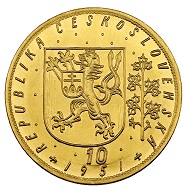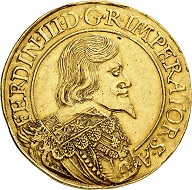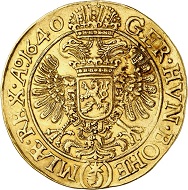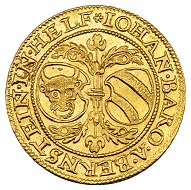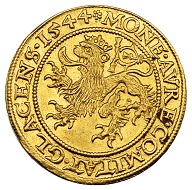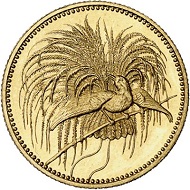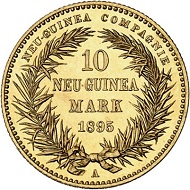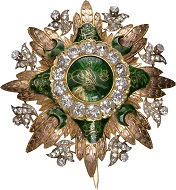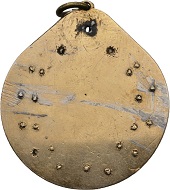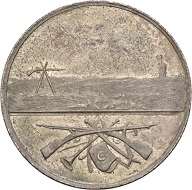24-09-2017 – 28-09-2017
Auctions 295-299
Fall Auctions in Osnabrück were attended by more than 400 bidders in person
In this age of internet, it is something very special when you have the privilege of welcoming hundreds of collectors and colleagues to your floor auctions. The auction house Künker is proud that its auctions have become an event which, despite all digitalization of the numismatic world, continues to provide so many coin enthusiasts with the opportunity to meet others who share their passion. And so, more than 400 bidders took the time to personally attend the Künker Fall Auctions on September 25-29, 2017. 2,600 bidders sent their bids. It is anything but a surprise, therefore, that the 5,800 lots with their estimates adding up to 7.5 million euros realized an impressive total of 12 million euros. An English 1826 gold coin of 5 pounds turned out to be the sale’s most expensive item. It obtained 200,000 euros.
295 / Lot 661: Polemon I of Bosporus for Augustus. Gold stater, year 289 (= 9/8 BC). From the collection of Grand Duke Alexander Mikhailovich Romanov. Extremely rare. Almost FDC showpiece. Estimate: 60,000,- euros. Hammer price: 80,000,- euros.
Coins from the ancient world
Whether Celtic, Greek, Roman, or Byzantine coins – high results were to be witnessed for coins from each of these periods. The pieces with the best grade imaginable were especially in demand. Once rarity and / or a good provenance added to this, the price rose.
A good example is the gold stater of King Polemon I of Bosporus. Even if the Bosporus is generally not at the focus of collectors’ interest, the fact that it was graded FDC and stemmed from the collection of Grand Duke Alexander Mikhailovich Romanov made it irresistible. The result amounted to 80,000 euros (estimate: 60,000 euros).
295 / Lot 832: Hadrian, 117-138. Cistophorus, 128-138, Nicomedia. From Leu sale 18 (1977), No. 330. Rare. Extremely fine showpiece. Estimate: 50,000,- euros. Hammer price: 85,000,- euros.
A cistophorus of Hadrian from Nicomedia is the second case in point. Its reverse features the Temple of Augustus. Graded extremely fine with its delicate toning and the best style possible, the showpiece can be traced as far back as the 1977 Leu sale 18. The hammer price: 85,000 euros (estimate: 50,000 euros).
Lot 1070: Tetricus I, 271-274. Aureus, 273/4, Cologne. Extremely rare. Extremely fine. Estimate: 50,000,- euros. Hammer price: 80,000,- euros.
The extremely rare and extremely fine aureus of Tetricus realized 80,000 euros on an estimate of 50,000 euros. That was to be expected.
295 / Lot 1155: Sebastianus, 412-413. Siliqua, Arelate. From Tkalec & Rauch (1985), No. 424. Extremely rare. Almost extremely fine. Estimate: 12,500,- euros. Hammer price: 65,000,- euros.
But not even the connoisseurs anticipated that one collector gladly paid 65,000 euros for a siliqua of Sebastianus (estimate: 12,500 euros). Well, a well-known expert from the British Museum certified its authenticity which is a relief for there are so many forgeries circulating on the market nowadays.
295 / Lot 709: Nero, 54-68. Sestertius, ca. 67, Lugdunum. From Leu sale 57 (1993), No. 254. Very rare. Almost extremely fine. Estimate: 20,000,- euros. Hammer price: 46,000,- euros.
An almost extremely fine sestertius of Nero, with the famous harbor scene on its reverse, proved that not just gold coins are much sought-after. It hammered at 46,000 euros, on an estimate of 20,000 euros.
295 / Lot 87: Populonia (Etruscans). AV-50 asses, 300-250 BC. From Hess-Leu sale 8 (1965), No. 3. From the Tetzlaff-Gahrmann Collection. Rare. Extremely fine.
Estimate: 5,000,- euros. Hammer price: 8,000,- euros.
Let us have a brief look at the Greek coins. The Tetzlaff-Gahrmann Collection consisting of Etruscan coins realized one-and-a-half times its estimate. A gold 50 asses piece from Populonia, with its provenance dating back as early as 1965, became the most expensive item. Having started at 5,000 euros, it was sold for 8,000 euros in the end.
295 / Lot 214: Syracuse (Sicily). Agathokles, 317-289 BC. Tetradrachm, 304-289. From Sternberg sale 13 (1983), No. 97. Extremely fine. Estimate: 7,500,- euros. Hammer price: 11,000,- euros.
A tetradrachm of Agathokles featuring Nike erecting on its reverse illustrated how important the style is when it comes to Greek coins. Struck from the artistically best dies known for this issue, the extremely fine piece obtained 11,000 euros on an estimate of 7,500 euros.
297 / Lot 3360: Eisleben. Schautaler 1624 on the jubilee of Luther’s 1524 visit in Eisleben. Extremely rare. Very fine+. Estimate: 12,500,- euros. Hammer price: 20,000,- euros.
Coins and medals from medieval and modern times
Let us move closer to our time. In Auction 296, world coins and medals were auctioned, among these the collection of a history enthusiast (German: ‘Geschichtsfreund’) who reconstructed the collection of another collector, the Leipzig-based merchant Georg Heinrich Sander. His efforts clearly paid off, as the results showed.
296 / Lot 1748: Solothurn (Switzerland). Taler 1501. From the collection of a history enthusiast. From Leu sale 66 (1996), Lot 61. Very rare. Very fine+. Estimate: 7,500,- euros. Hammer price: 24,000,- euros.
A 1501 taler from the city of Solothurn yielded 24,000 euros (estimate: 15,000 euros), …
296 / Lot 1938: Schlick. Stephan Burian, Heinrich, Hieronymus, and Lorenz, 1505-1532. Double taler 1520, Joachimstal, with the title of Ludwig II, King of Hungary and Bohemia. From the collection of a history enthusiast. From the Köhlmoos Collection, MMAG 91 (2001), No. 889. Extremely rare. Very fine. Estimate: 20,000,- euros. Hammer price: 38,000,- euros.
… a 1520 double taler from Schlick 38,000 euros (estimate: 20,000 euros), …
296 / Lot 2355: Jülich-Berg. Philipp Wilhelm, 1653-1679. Reichstaler 1663, Düsseldorf. From the collection of a history enthusiast. From the Schulthess-Rechberg Collection (1869), No. 4327. Extremely rare. Almost extremely fine. Estimate: 10,000,- euros. Hammer price: 30,000,- euros.
… a reichstaler from Jülich-Kleve-Berg dating from 1663 – its provenance dating back as early as 1857, it made the cover piece of Sander’s first book – 30,000 euros (estimate: 10,000 euros), …
296 / Lot 2637: Saxony. Friedrich August I, 1694-1733 (‘Augustus the Strong’). Reichstaler no date. (1705), Dresden. On the restauration of the Polish Order of the White Eagle. Very rare. Extremely fine. Estimate: 25,000,- euros. Hammer price: 30,000,- euros.
… a 1694 reichstaler from Öttingen-Wallerstein 10,000 euros (estimate: 3,000 euros), and a reichstaler of Augustus the Strong of Saxony on the restoration of the Polish Order of the White Eagle 30,000 euros (estimate: 25,000 euros). In other words: In the end, the collection of the history enthusiast doubled its pre-sale estimate.
If you want to learn more about the collection of the history enthusiast and the original Sander collection, don’t miss this film.
296 / Lot 2751: Wallenstein. Albrecht, 1623-1634. Reichstaler 1629, Jicin. From the Stricker Collection. Very rare. Very fine to extremely fine. Estimate: 7,500,- euros. Hammer price: 26,000,- euros.
The Stricker Collection was no different: With its estimate of 7,500 euros, the top item had been a reichstaler of Albrecht von Wallenstein from Jicin. It crossed the auction block for 26,000 euros.
296 / Lot 2727: Solms-Laubach. Friedrich Ludwig Christian, 1784-1822. Silver trial strike from the dies of the copper schnepfenheller 1805, Frankfurt. From the Horn Collection. Probably 3rd known specimen. Very fine. Estimate: 1,000,- euros. Hammer price: 9,500,- euros.
To conclude, let us have a look at an inconspicuous piece which no layman would have considered something extraordinary. From the Horn Collection came a silver trial strike of a copper 1805 schnepfenheller from Solms-Laubach. Only three examples are known to exist. The coin had a pre-sale estimate of only 1,000 euros. The hammer price was as high as 9,500 euros! The experts were well aware of this coin’s rarity.
Opitz Collection – Reformation coins and medals
Those interested in Reformation coins and medals can’t get past the Opitz Collection. 1,000 items from this collection were offered at Künker Auction 297.
297 / Lot 3712: Saxony. Christian I, 1586-1591. 2 ducats 1590, Dresden. Very rare. Extremely fine. Estimate: 25,000,- euros. Hammer price: 50,000,- euros.
The top item was a 1590 double ducat, struck in Dresden on behalf of Christian I. This elector reigned for only five years. He ranges among the few who wanted to forge an alliance with the Calvinists, to enable them to also benefit from the 1555 Peace of Augsburg which only the Protestants enjoyed. Realizing 50,000 euros, the coins exactly doubled their estimate.
The historical background of the Reformation is explaned through coins and medals from the Opitz collection in this film.
297 / Lot 3350: Braunschweig-Lüneburg-Celle. Friedrich, 1636-1648. Löser of 4 reichstalers 1647, Clausthal, on the imminent end of the 30 Years’ War. Extremely rare. Extremely fine. Estimate: 25,000,- euros. Hammer price: 42,000,- euros.
A quadruple löser from 1647 with a depiction that refers to the end of the Thirty Years’ War sold for 42,000 euros. It stemmed from the Brand Collection (estimate: 25,000 euros).
The famous schautaler of Frederick III the Wise of Saxony, which was to become the model for the renowned 3 mark (Jäger 141) had been appraised at 7,500 euros, only to cross the auction block for 24,000 euros.
298 / Lot 4266: China. Trial strikes of the Prägeanstalt Otto Beh, Esslingen. Kwangtung Province. 1 dollar (7 mace, 2 candareens), no date (1890). Brass pattern made by the Louis Schuler company, Göppingen. Probably the only specimen available on the market. Extremely fine. Estimate: 20,000,- euros. Hammer price: 55,000,- euros.
Gold strikings / Russian coins and medals / Post-1871 German coins
55,000 euros for a pattern that the Schuler company had produced for China using the dies made by the Prägeanstalt Otto Beh (estimate: 20,000 euros) proved to be the highest result from the spectacular collection of Chinese coins sold at the Künker Auction. Impressive though this figure is – it is only one of many hammer prices of Catalog 298 that exceeded the 50,000-euros-boundary.
298 / Lot 4349: Great Britain. George IV, 1820-1830. 5 pounds 1826, London. Only 150 specimens struck. From the Phoibos Collection. Graded PCGS PR64 Deep Cameo. Proof, minimally touched. Estimate: 25,000,- euros. Hammer price: 200,000,- euros.
The most expensive coin of the sale became 5 pounds 1826 from the Phoibos collection of which only 150 specimens were struck. PCGS had graded it PR64 Deep Cameo, hence Mint State which PCGS further divides into 11 tiers, from PR60 to PR70. A bidder spent 200,000 euros for this coin.
298 / Lot 4412: Holland Province / Netherlands. 10 ducats 1721. Gold first strike from the dies of the silver dukaton. From the Phoibos Collection. Very rare. Extremely fine to FDC. Estimate: 20,000,- euros. Hammer price: 180,000,- euros.
Also from the Phoibos Collection came a 10 ducat 1721 from the Netherlands. The gorgeous piece, sharply struck and of a minting quality that reminds of the modern proof, changed hands for 180,000 euros, on an estimate of 20,000 euros.
298 / Lot 4441: Romania. Carol II, 1930-1940. 100 lei 1939, Bucharest, on the 100th birthday of Carol I. From the Phoibos Collection. Extremely rare. Extremely fine. Estimate: 20,000,- euros. Hammer price: 52,500,- euros.
Two extremely rare Romanian 100 lei pieces from 1939, both from the Phoibos Collection, obtained 52,500 euros each. Their estimates had been 15,000 euros and 20,000 euros. They vouch for the enormous increase in value that rare 20th century gold coins have experienced in recent years.
298 / Lot 4519: Czechoslovakia. 10 ducats 1951, Kremnitz. From the Phoibos Collection. Only 56 specimens struck. FDC. Estimate: 30,000,- euros. Hammer price: 90,000,- euros.
Another telling example is the 1923-1951 coins from Czechoslovakia. The estimates of the 43 lots – containing nothing but gold coins – added up to 130,000 euros. They hammered at a total of 332,000 euros in the end. Great rarities as the almost FDC 10 ducat piece from 1951 with its 90,000 euros were of course mainly responsible for this result. But the “frequent” pieces with their lower estimates amazed as well. A 1934 ducat in almost FDC, for instance, realized 2,000 euros (estimate: 300 euros).
298 / Lot 4630: Holy Roman Empire. Ferdinand III, 1625-1637-1657. 10 ducats 1640, Prague. From the Phoibos Collection. Very rare. Very fine+. Estimate: 10,000,- euros. Hammer price: 60,000,- euros.
To turn to the Holy Roman Empire: The coins of the German emperors offered more than one surprise, too. Suffice it to mention only two examples: a 10 ducat piece, struck in Prague in 1640, again from the Phoibos Collection, obtained a hammer price of 60,000 euros (estimate: 10,000 euros). The same denomination from Salzburg, a so-called “turmprägung” (“tower coinage”) from 1594, yielded the exact same result (estimate: 20,000 euros).
298 / Lot 4971: Nuremberg. 5 ducats 1698 on the centenary of the Peace of Ryswick. From the Phoibos Collection. Very rare. Graded PCGS MS62. Almost FDC. Estimate: 10,000,- euros. Hammer price: 55,000,- euros.
Last but not least, coins from the German States bring excellent prices but still are affordable, when compared against some other nations – just think of Great Britain and Czechoslovakia. Stemming from the Phoibos Collection and graded PCGS MS62 (hence almost FDC), a 5 ducat piece realized 55,000 euros (estimate: 10,000 euros).
298 / Lot 5040: Glatz. Johann von Pernstein, 1537-1548. Ducat 1544, Glatz. From the Phoibos Collection. Extremely rare. Extremely fine to FDC. Estimate: 20,000,- euros. Hammer price: 34,000,- euros.
A 1544 ducat of Johann von Pernstein for the Duchy of Glatz – also stemming from the Phoibos Collection – changed hands for 34,000 euros (estimate: 20,000 euros).
298 / Lot 5859: German Empire. 10 Neu-Guinea marks 1895. J. 708. From the Phoibos Collection. Only 2,000 Specimens struck. FDC. Estimate: 30,000,- euros. Hammer price: 75,000,- euros.
The wonderful coins made for German-New Guinea during the era of the German Empire belong to the favorite coins of German collectors. They love the beautiful obverse featuring a bird of paradise created by Otto Beh. Which pays. A collector was gladly willing to bid 75,000 euros for a prefect example from the Phoibos Collection (estimate: 30,000 euros).
Do we even have to explicitly mention that the Phoibos Collection of gold coins in outstanding grade sold splendidly? Altogether, it realized more than three times its estimate.
Orders and decorations
Let us conclude this review with some exorbitant results from Künker Auction 299 comprising orders and decorations. Among the material on offer was the Ottoman Collection, probably the most important and richest collection of Ottoman decorations ever to enter the market.
299 / Lot 7176: High Order of Distinction. Breast Star, variant with diamonds in medallion ring. From the Ottoman Collection. RRRR. II. Estimate: 50,000,- euros. Hammer price: 85,000,- euros.
The auction’s top-seller was a Breast Star of the “High Order of Distinction”. On its estimate of 50,000 euros, it realized 85,000 euros.
299 / Lot 7197: Medal of Achievement of the Order of Glory. 1831. From the Ottoman Collection. RRRR. II. Estimate: 5,000,- euros. Hammer price: 38,000,- euros.
While this had been expected, Lot 7197 sprang a big surprise. Bearing the inscription “Order of Distinction”, it is an enigmatic medal with not much known about its function. Estimated at a modest 5,000 euros, the piece, decorated with 45 diamonds, sold for 38,000 euros.
299 / Lot 7247: Medal for Marksmanship. From the Ottoman Collection. II. Estimate: 100,- euros. Hammer price: 20,000,- euros.
A medal for marksmanship made an even greater jump. Issued in 1863, we do not know much about its historical background. It had been estimated at 100 euros. The hammer price was 20,000 euros (sic!). Amounting to 30,000 euros, the price for a commemorative medal on the erection of a memorial for the constitution was almost as spectacular (estimate: 1,000 euros). This memorial in honor of the Young Turks who lost their lives in the fight for power had been inaugurated on March 31, 1911.
This shows that collecting unexplored areas will pay off. You can make some discoveries indeed.
You can view all results online at the Künker website. The next auction will take place on the occasion of the World Money Fair in Berlin, on February 1, 2018. Request your catalog at Künker, Nobbenburgerstr. 4a, 49 076 Osnabrück; phone: +49 541 / 96 20 20; fax: +49 541 / 96 20 222; or via e-mail.



